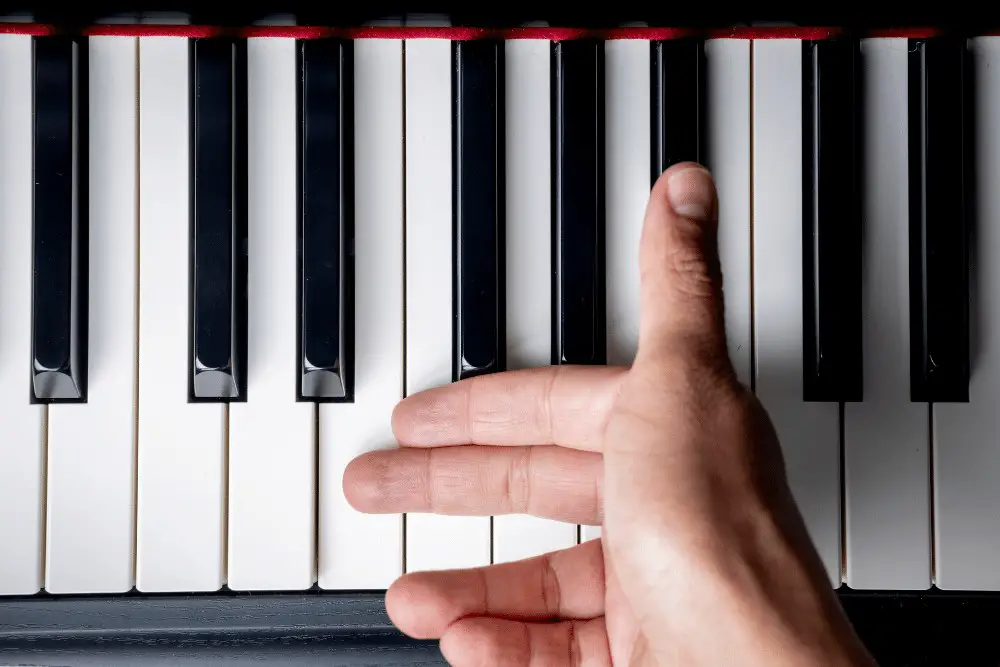Have you heard a pianist performing a glissando?
Do you wonder how to play that fun-sounding technique?
Look no further; I’m here to help.
The glissando isn’t as common in real piano playing as in the movies and on television, but it’s still fun to play.
I’ve been a music teacher and piano lessons instructor for over 10 years, and my students (young and old!) always ask me how to do this.
I’m happy to share this with them because it sparks their interest.
And I’m happy to share with you!
Table of Contents
How To Glissando On Piano
A glissando, or gliss, on a piano is when you start either high or low and run your fingers down the keys hitting all the notes on the way. The sound you get when using your fingernail is often described as a glide. With practice, any person can learn this technique.
In sheet music, it’s shown with a squiggly line going between two notes.
You must aim for these two notes as you play the gliss.
Here are the basic steps:
- With your index finger on one of your hands, play the first note shown by the notation (even if it’s a black key note).
- Using the other hand’s index or middle finger, drag your finger lightly across the keys toward the other note shown.
- Experiment with the strength and position to get a good sound without hurting your finger.
- Use the back or side of your finger as you glide across to gliss.
- Many use their nails to make contact with the keys (after all, there isn’t as much feeling in your nails).
- As you approach the end-note, use your first hand and finger to play it as you lift your sliding finger off.
That’s basically it. Do this 100 times, and it’ll be easier and easier.
You may also want to check out this video on how to gliss.
How Do You Glissando Without Hurting Your Hand?
At first, it may hurt when you play this, but it shouldn’t. You just need to learn the proper positioning.
Upward and downward glissandos don’t feel any different from one another, but you may find it easier to go up at first.
If it hurts, you’re pushing too hard. Use less of your finger and more of your nails.
Some suggest using your thumbnail. I find this is a weird and impractical way to do a gliss.
You’ll have a hard time getting your hands back into playing position.
If you have a keyboard, you may find it less painful to perform a glissando. The plastic keys are usually a little easier on your fingers.
Looking for a good keyboard? I love the Yamaha DGX660B.
It has 88 weighted keys and sounds almost exactly like a real, acoustic piano (and it even sounds better than some!).
You may want to experiment with using your index or middle finger. For some, it works easier one way or the other.
How Do You Play A Black Glissando On Piano?
Typically, you use the white keys even if you start or end on a black key when doing a glissando.
However, if both keys are black or you want a more open sound, you may try a black-key glissando.
This variation of piano technique requires the same steps, only you play the black keys exclusively.
Other Piano Learning Resources
If you find yourself struggling to learn glissando or other piano knowledge on your own, please don’t give up.
You have a lot of options.
First, I’d always recommend finding a piano instructor for lessons.
They’ll be able to give you in-person feedback to help you learn faster.
The obvious downsides of this include:
- Weekly commitments
- Up to $50 per week in lesson costs
- Potential personality conflicts
- Being left to practice on your own between lessons
Still, the personal feedback from an expert makes up for these downsides.
If you wish to quit your piano lessons, read this article first!
You may wish to try just learning from YouTube. But to be honest, this almost never works.
You need to already have some skill to succeed in this form of E-learning.
If you’re looking for online lessons, be careful.
Either go for a 1-on-1 video lesson OR find a trusted program, such as Flowkey.
I love Flowkey for my students. They have the perfect combination of courses, learning tools, and thousands of songs to learn.
What Instruments Can Glissando?
If you’re interested in hearing glissando on other instruments, you’re in luck! Almost every instrument can do it!
Kind of…
Most music teachers agree only the trombone can truly perform a glissando.
The piano, string instruments such as the violin, clarinets, and saxophones can get pretty close.
Other instruments can fake it enough it sounds like a gliss, but it’s not as close to the true meaning of the word.
A real glissando is a slide from one note to another while hitting every note in between quickly and smoothly in a gliding motion.
Final Thoughts
Learning how to glissando on the piano isn’t hard; it’s the time it takes to master it where people get tripped up.
Don’t give up on learning it if you’re interested.
With time and practice, you’ll impress your friends with this cool piano technique!


